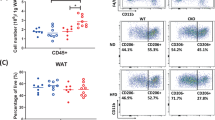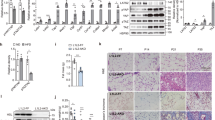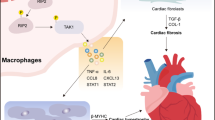Abstract
Several studies have implicated obesity-induced macrophage–adipocyte cross-talk in adipose tissue dysfunction and insulin resistance. However, the molecular cues involved in the cross-talk of macrophage and adipocyte causing insulin resistance are currently unknown. Here, we found that a lipid-induced monokine cyclophilin-A (CyPA) significantly attenuates adipocyte functions and insulin sensitivity. Targeted inhibition of CyPA in diet-induced obese zebrafish notably reduced adipose tissue inflammation and restored adipocyte function resulting in improvement of insulin sensitivity. Silencing of macrophage CyPA or pharmacological inhibition of CyPA by TMN355 effectively restored adipocytes’ functions and insulin sensitivity. Interestingly, CyPA incubation markedly increased adipocyte inflammation along with an impairment of adipogenesis, however, mutation of its cognate receptor CD147 at P309A and G310A significantly waived CyPA’s effect on adipocyte inflammation and its differentiation. Mechanistically, CyPA–CD147 interaction activates NF-κB signaling which promotes adipocyte inflammation by upregulating various pro-inflammatory cytokines gene expression and attenuates adipocyte differentiation by inhibiting PPARγ and C/EBPβ expression via LZTS2-mediated downregulation of β-catenin. Moreover, inhibition of CyPA or its receptor CD147 notably restored palmitate or CyPA-induced adipose tissue dysfunctions and insulin sensitivity. All these results indicate that obesity-induced macrophage–adipocyte cross-talk involving CyPA–CD147 could be a novel target for the management of insulin resistance and type 2 diabetes.









Similar content being viewed by others
Data availability
The datasets used and/or analyzed during the current study are available from the corresponding author on reasonable request.
References
Morigny P, Boucher J, Arner P, Langin D (2021) Lipid and glucose metabolism in white adipocytes: pathways, dysfunction and therapeutics. Nat Rev Endocrinol 17(5):276–295
Longo M, Zatterale F, Naderi J, Parrillo L, Formisano P, Raciti GA, Beguinot F, Miele C (2019) Adipose tissue dysfunction as determinant of obesity-associated metabolic complications. Int J Mol Sci 20(9):2358
Hammarstedt A, Gogg S, Hedjazifar S, Nerstedt A, Smith U (2018) Impaired adipogenesis and dysfunctional adipose tissue in human hypertrophic obesity. Physiol Rev 98:1911–1941
Muir LA, Neeley CK, Meyer KA et al (2016) Adipose tissue fibrosis, hypertrophy, and hyperplasia: correlations with diabetes in human obesity. Obesity (Silver Spring) 24(3):597–605
Liu F, He J, Wang H, Zhu D, Bi Y (2020) Adipose morphology: a critical factor in regulation of human metabolic diseases and adipose tissue dysfunction. Obes Surg 30:5086–5100
Pal D, Dasgupta S, Kundu R et al (2012) Fetuin-A acts as an endogenous ligand of TLR4 to promote lipid-induced insulin resistance. Nat Med 18:1279–1285
McKernan K, Varghese M, Patel R, Singer K (2020) Role of TLR4 in the induction of inflammatory changes in adipocytes and macrophages. Adipocyte 9(1):212–222
Lancaster GI, Langley KG, Berglund NA et al (2018) Evidence that TLR4 is not a receptor for saturated fatty acids but mediates lipid-induced inflammation by reprogramming macrophage metabolism. Cell Metab 27:1096–1110
Kriebs A (2021) Accumulation of macrophages in adipose tissue. Nat Rev Endocrinol 17:4
Russo L, Lumeng CN (2018) Properties and functions of adipose tissue macrophages in obesity. Immunology 155(4):407–417
Zheng C, Yang Q, Cao J et al (2016) Local proliferation initiates macrophage accumulation in adipose tissue during obesity. Cell Death Dis 7:e2167
Boutens L, Stienstra R (2016) Adipose tissue macrophages: going off track during obesity. Diabetologia 59:879–894
Guglielmi V, Cardellini M, Cinti F et al (2015) Omental adipose tissue fibrosis and insulin resistance in severe obesity. Nutr Diabetes 5:e175
Lee CH, Lam KSL (2019) Obesity-induced insulin resistance and macrophage infiltration of the adipose tissue: a vicious cycle. J Diabetes Investig 10(1):29–31
Ramkhelawon B, Hennessy EJ, Ménager M et al (2014) Netrin-1 promotes adipose tissue macrophage retention and insulin resistance in obesity. Nat Med 20:377–384
Lee YS, Olefsky J (2021) Chronic tissue inflammation and metabolic disease. Genes Dev 35:307–328
Thomas D, Apovian CM (2017) Macrophage functions in lean and obese adipose tissue. Metabolism 72:120–143
Zhang Y, Mei H, Chang X, Chen F, Zhu Y, Han X (2016) Adipocyte-derived microvesicles from obese mice induce M1 macrophage phenotype through secreted miR-155. J Mol Cell Biol 8(6):505–517
Orecchioni M, Ghosheh Y, Pramod AB, Ley K (2019) Macrophage polarization: different gene signatures in M1(LPS+) vs. classically and M2(LPS–) vs. alternatively activated macrophages. Front Immunol 10:1084
Xue C, Sowden MP, Berk BC (2018) Extracellular and intracellular cyclophilin A, native and post-translationally modified, show diverse and specific pathological roles in diseases. Arterioscler Thromb Vasc Biol 38:986–993
Nigro P, Pompilio G, Capogrossi MC (2013) Cyclophilin A: a key player for human disease. Cell Death Dis 4:e888
Ramachandran S, Venugopal A, Charles S et al (2012) Proteomic profiling of high glucose primed monocytes identifies cyclophilin A as a potential secretory marker of inflammation in type 2 diabetes. Proteomics 12:2808–2821
Mao M, Yu X, Ge X et al (2017) Acetylated cyclophilin A is a major mediator in hypoxia-induced autophagy and pulmonary vascular angiogenesis. J Hypertens 35(4):798–809
Yang W, Bai X, Luan X et al (2022) Delicate regulation of IL-1β-mediated inflammation by cyclophilin A. Cell Rep 38:110513
Satoh K, Nigro P, Berk BC (2010) Oxidative stress and vascular smooth muscle cell growth: a mechanistic linkage by cyclophilin A. Antioxid Redox Signal 12(5):675–682
Muramatsu T (2016) Basigin (CD147), a multifunctional transmembrane glycoprotein with various binding partners. J Biochem 159(5):481–490
Yurchenko V, Zybarth G, O’Connor M et al (2002) Active site residues of cyclophilin A are crucial for its signaling activity via CD147. J Biol Chem 277:22959–22965
Anandan V, Thulaseedharan T, Suresh Kumar A et al (2021) Cyclophilin A impairs efferocytosis and accelerates atherosclerosis by overexpressing CD47 and down-Regulating calreticulin. Cells 10:3598
Ramachandran S, Venugopal A, Kutty VR et al (2014) Plasma level of cyclophilin A is increased in patients with type 2 diabetes mellitus and suggests presence of vascular disease. Cardiovasc Diabetol 13:1–8
Ramachandran S, Vinitha A, Kartha CC (2016) Cyclophilin A enhances macrophage differentiation and lipid uptake in high glucose conditions: a cellular mechanism for accelerated macro vascular disease in diabetes mellitus. Cardiovasc Diabetol 15:1–19
Zang L, Shimada Y, Nishimura N (2017) Development of a novel zebrafish model for type 2 diabetes mellitus. Sci Rep 7:1–11
Babaei F, Ramalingam R, Tavendale A et al (2013) Novel blood collection method allows plasma proteome analysis from single zebrafish. J Proteome Res 12:1580–1590
Dasgupta S, Bhattacharya S, Maitra S et al (2011) Mechanism of lipid induced insulin resistance: activated PKCε is a key regulator. Biochim Biophys Acta Mol Basis Dis 1812:495–506
Lowry OH, Rosebrough NJ, Farr AL, Randall RJ (1951) Protein measurement with the Folin phenol reagent. J Biol Chem 193:265–275
Kearney AL, Norris DM, Ghomlaghi M et al (2021) Akt phosphorylates insulin receptor substrate to limit PI3K-mediated PIP3 synthesis. eLife 10:e66942
Di Camillo B, Eduati F, Nair SK, Avogaro A, Toffolo GM (2014) Leucine modulates dynamic phosphorylation events in insulin signalling pathway and enhances insulin-dependent glycogen synthesis in human skeletal muscle cells. BMC Cell Biol 15:9
Chanda A, Kalita B, Patra A, Senevirathne WDST, Mukherjee AK (2019) Proteomic analysis and antivenomics study of Western India Naja naja venom: correlation between venom composition and clinical manifestations of cobra bite in this region. Expert Rev Proteom 16:171–184
Mukherjee S, Chattopadhyay M, Bhattacharya S, Dasgupta S, Hussain S et al (2017) A small insulinomimetic molecule also improves insulin sensitivity in diabetic mice. PLoS ONE 12:e0169809
Arora K, Gwinn WM, Bower MA et al (2005) Extracellular cyclophilins contribute to the regulation of inflammatory responses. J Immunol 175:517–522
Wu H, Ballantyne CM (2020) Metabolic inflammation and insulin resistance in obesity. Circ Res 126:1549–1564
Gregor MF, Hotamisligil GS (2011) Inflammatory mechanisms in obesity. Annu Rev Immunol 29:415–445
Glass CK, Olefsky JM (2012) Inflammation and lipid signaling in the etiology of insulin resistance. Cell Metab 15:635–645
Napetschnig J, Wu H (2013) Molecular basis of NF-κB signaling. Annu Rev Biophys 42:443–468
Xu Q, Leiva M, Fischkoff S, Handschumacher R, Lyttle C (1992) Leukocyte chemotactic activity of cyclophilin. J Biol Chem 267:11968–11971
Cristancho AG, Lazar MA (2011) Forming functional fat: a growing understanding of adipocyte differentiation. Nat Rev Mol Cell Biol 12:722–734
Schlegel J, Redzic JS, Porter CC et al (2009) Solution characterization of the extracellular region of CD147 and its interaction with its enzyme ligand cyclophilin A. J Mol Biol 391:518–535
Christodoulides C, Lagathu C, Sethi JK, Vidal-Puig A (2009) Adipogenesis and WNT signalling. Trends Endocrinol Metab 20:16–24
Ma B, Hottiger MO (2016) Crosstalk between Wnt/β-catenin and NF-κB Signaling pathway during inflammation. Front Immunol 7:378
Cho HH, Song JS, Yu JM et al (2008) Differential effect of NF-κB activity on β-catenin/Tcf pathway in various cancer cells. FEBS lett 582:616–622
Chang J, Liu F, Lee M et al (2013) NF-κB inhibits osteogenic differentiation of mesenchymal stem cells by promoting β-catenin degradation. Proc Natl Acad Sci USA 110:9469–9474
Dooley K, Zon LI (2000) Zebrafish: a model system for the study of human disease. Curr Opin Genet Dev 10:252–256
Kinkel MD, Prince VE (2009) On the diabetic menu: zebrafish as a model for pancreas development and function. Bioessays 31:139–152
Oka T, Nishimura Y, Zang L et al (2010) Diet-induced obesity in zebrafish shares common pathophysiological pathways with mammalian obesity. BMC Physiol 10:1–13
Handschumacher RE, Harding MW, Rice J, Drugge RJ, Speicher DW (1984) Cyclophilin: a specific cytosolic binding protein for cyclosporin A. Science 226:544–547
Colgan J, Asmal M, Yu B, Luban J (2005) Cyclophilin A-deficient mice are resistant to immunosuppression by cyclosporine. J Immunol 174:6030–6038
Sweeney ZK, Fu J, Wiedmann B (2014) From chemical tools to clinical medicines: nonimmunosuppressive cyclophilin inhibitors derived from the cyclosporin and sanglifehrin scaffolds. J Med Chem 57:7145–7159
Baugh J, Gallay P (2012) Cyclophilin involvement in the replication of hepatitis C virus and other viruses. Biol Chem 393:579–587
Davra VK, Saleh T, Geng K et al (2020) Cyclophilin A inhibitor Debio-025 targets Crk, reduces metastasis, and induces tumor immunogenicity in breast cancer. Mol Cancer Res 18:1189–1201
Kuo J, Bobardt M, Chatterji U et al (2019) A pan-cyclophilin inhibitor, CRV431, decreases fibrosis and tumor development in chronic liver disease models. J Pharmacol Exp Ther 371:231–241
Boden G (2011) Obesity, insulin resistance and free fatty acids. Curr Opin Endocrinol Diabetes Obes 18:139
Hotamisligil GS, Shargill NS, Spiegelman BM (1993) Adipose expression of tumor necrosis factor-alpha: direct role in obesity-linked insulin resistance. Science 259:87–91
Liang C-P, Han S, Senokuchi T, Tall AR (2007) The macrophage at the crossroads of insulin resistance and atherosclerosis. Circ Res 100:1546–1555
Odegaard JI, Chawla A (2012) Connecting type 1 and type 2 diabetes through innate immunity. Cold Spring Harb Perspect Med 2:a007724
Sica A, Mantovani A (2012) Macrophage plasticity and polarization: in vivo veritas. J Clin Invest 122:787–795
Coats BR, Schoenfelt KQ, Barbosa-Lorenzi VC et al (2017) Metabolically activated adipose tissue macrophages perform detrimental and beneficial functions during diet-induced obesity. Cell Rep 20(13):3149–3161
Hill DA, Lim HW, Kim YH et al (2018) Distinct macrophage populations direct inflammatory versus physiological changes in adipose tissue. Proc Natl Acad Sci USA 15(22):E5096–E5105
Jaitin DA, Adlung L, Thaiss CA et al (2019) Lipid-associated macrophages control metabolic homeostasis in a Trem2-dependent manner. Cell 178(3):686–698
Biswas C, Zhang Y, DeCastro R et al (1995) The human tumor cell-derived collagenase stimulatory factor (renamed EMMPRIN) is a member of the immunoglobulin superfamily. Cancer Res 55:434–439
Acknowledgements
D. B. and S. R. expresses their gratitude to the DBT for the award of Research Fellowship. D. B. and A. S. acknowledges the ‘Research and Innovation Grant (DoRD/RIG/10-73/1592-A)’ from Tezpur University. De. P. acknowledges IIT Ropar and MHRD for his Research Fellowship. We thank Dr. R. Mukhopadhyay, Department of MBBT, Tezpur University, for the gift of THP-1 monocyte cell line and the National Center for Cell Science (NCCS), Pune for providing RAW264.7 macrophage cell line. We are also thankful to the Head, Department of MBBT, Tezpur University, the Head, Department of BME, Indian Institute of Technology Ropar, the Head, Department of Pharmacology and Toxicology, NIPER S.A.S. Nagar, and the Dean, College of Fisheries, Assam Agricultural University for extending the facilities required for the present investigation. Financial support in the form of UGC-SAP-DRS-II, and DST-FIST-I to the Department of MBBT, Tezpur University is also acknowledged.
Funding
This work was supported by the “DBT-Twinning Grant” from the Department of Biotechnology (DBT), New Delhi (Grant number: BT/PR24700/NER/95/819/2017)” to S.D.G. (Tezpur University) and D.P. (IIT Ropar). The SERB-Early Career Research Grant from the Science and Engineering Research Board (SERB), New Delhi (Grant number: ECR/2017/000892) to D.P. also supported this work.
Author information
Authors and Affiliations
Contributions
SDG, DP, and DB conceived and designed the experiments. DB, DeP, AS, SR, RP, RS performed the experiments. SDG, DP, KT, DB, and DeP analyzed the data. RS, RD, and SKB developed obese diabetic zebrafish model and helped in experiments. RP and KT developed mice models and helped in experiments. SDG, DP, and DB wrote the manuscript. SDG and DP supervised the study. All authors read and approved the final manuscript. SDG is the guarantor of this work and, as such, had full access to all the data in the study and takes responsibility for the integrity of the data and the accuracy of the data analysis.
Corresponding authors
Ethics declarations
Conflict of interest
No potential conflicts of interest relevant to this article were reported.
Additional information
Publisher's Note
Springer Nature remains neutral with regard to jurisdictional claims in published maps and institutional affiliations.
Supplementary Information
Below is the link to the electronic supplementary material.
Rights and permissions
About this article
Cite this article
Banerjee, D., Patra, D., Sinha, A. et al. Lipid-induced monokine cyclophilin-A promotes adipose tissue dysfunction implementing insulin resistance and type 2 diabetes in zebrafish and mice models of obesity. Cell. Mol. Life Sci. 79, 282 (2022). https://doi.org/10.1007/s00018-022-04306-1
Received:
Revised:
Accepted:
Published:
DOI: https://doi.org/10.1007/s00018-022-04306-1




